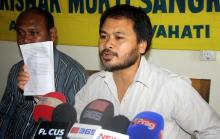A team of experts from ICIMOD (International Centre for Integrated Mountain Development, Kathmandu, Nepal) have installed flood early warning systems (FEWS) enabled by wireless technology along the Jiadhal and Singara rivers in Assam, India. The installation was carried out under the Himalayan Climate Change Adaptation Programme (HICAP) and is intended to minimize the flood risks and enhance the adaptive capacity of the communities. Before being installed, the FEWS were tested for six months at the ICIMOD Knowledge Park at Godavari in the Kathmandu Valley, Nepal. Two main lessons can be drawn from the Mahakali and Uttarakhand flood disasters: The severity of the disaster could have been mitigated with a better end-to-end information system and proper infrastructure planning would have reduced the damage
As a regional knowledge and learning centre serving the eight countries of the Hindu Kush Himalayas – Afghanistan, Bangladesh, Bhutan, China, India, Myanmar, Nepal, and Pakistan – ICIMOD is uniquely placed to address issues of a transboundary nature. ICIMOD is focused on improving our understanding of the complex hydrological processes of the Hindu Kush Himalayan region and promoting data and information sharing. It seeks to facilitate cooperation on policies, the timely sharing of information, and the proper management of the water resources.
ICIMOD is working for an economically and environmentally sound mountain ecosystem to improve the living standards of mountain people and sustain vital ecosystem services – now and for the future. ICIMOD has chosen to focus on hazards and disasters related to adverse weather and climate conditions, such as high intensity rainfall, glacial lake outburst floods, regional floods, and flash floods. In order to address the risks facing mountain communities and better understand the nature of hazards that might lead to disasters, ICIMOD has outlined a series of activities to be undertaken as part of ‘Disaster risk reduction and community resilience’ including the: assessment of vulnerability of communities and building their resilience to multi-hazards; assessment of the impact of climate change on ecosystems, natural hazards, and human health; delivery of training in disaster risk reduction; and provision of a platform for sharing knowledge and experiences within disaster risk reduction.
ICIMOD, in partnership with the World Meteorological Organization and partner countries from Bangladesh, Bhutan, China, India, Nepal, and Pakistan, is working to establish a regional flood information system. Twenty-four hydrometeorological stations have been installed to share real time data to strengthen flood forecasting in four countries. In Nepal, nine hydrometeorological stations have been installed in the Koshi basin and eight in the Kailash Sacred Landscape. ICIMOD aims to assist mountain people in implementing improved disaster risk reduction at national and regional levels addressing upstream-downstream linkages for saving lives and livelihoods. This is achieved through the implementation of transboundary programmes in partnership with regional partner institutions, exploring the application of satellite-based technologies for disaster risk reduction, supporting networking, facilitating the exchange of experience, and serving as a regional knowledge hub, among other things. Institutional strengthening and capacity building of our partner institutions is also being undertaken to contribute to effective disaster risk reduction.
In Assam, the first FEWS set was installed at Sagarpur village, Naboisa Circle, Lakhimpur District, on the occasion of World Environment Day – 5th June 2013 with help of Aaryanak, a environmental NGO. Dr. Rajiv Dutta Choudhury, District Programme Officer-Disaster Management, Lakhimpur District, was present on the occasion and observed the installation process. Two other sites were finalized for FEWS installation on the Singara river (No.1 Bogibeel) and Jiadhal river (Balisori-Renga village).
On 7 June, two days after the FEWS installation at Sagarpur, the equipment successfully provided a first level alarm. At around 06.30 pm, the alarm sounded when the water level suddenly increased in the Singara river following incessant rainfall in the hills and adjoining plains. A moderate flash flood wave resulted in water spilling over the banks and inundating agricultural areas. Settlements were only slightly affected.
The FEWS comprises the assembly of simple instrument such as a flood gauge connected through cable to a control unit powered by solar panels. The electronic sensors fitted inside the flood gauge at different heights (to indicate different risk levels) produce alarming sound when water rises in the river and touches the flood gauge at those marks of risk levels. The control unit is set up in a household living near to the river. The household/family should be one that volunteers to take the responsibility of looking after the instruments and disseminate the flood warning information in the village as well as to other villages whenever required.
The instruments provided warning alarm to the villagers correctly on several occasions of flash floods in the Jiadhal River in that rainy season in 2010. The warning provided during the night time was particularly useful to the villagers. The warnings received by the host community (who hosted the FEWS system) were disseminated to downstream villages along the river using mobile phones through a network of volunteers working from different flood prone villages from upstream foothills to downstream flood plains. It was found that community’s flood risk can be significantly reduced by providing early warning that reaches them at least with a lead of 1 to 2 hours. It was observed that communities could actually save their valuable assets like livestock after they had received early food information.
The ICIMOD team also delivered two hands-on training events, one on FEWS installation, the other on troubleshooting. Thirteen participants took part in the training and demonstration of FEWS installation. The FEWS equipment has been handed over to Aaranyak for further installation and one of sets is installed in Dhemaji district. Although some warnings were disseminated by the India Meteorological Organization about the possibility of high to intense rainfall, this information was not transmitted to the people at risk. There is a need to strengthen disaster management and preparedness mechanisms, which requires awareness and sensitization at various levels to ensure that early warning information is conveyed to end users well in advance. Advances in technology have made it possible to provide three to four hours warning of such events – which is enough to save lives. We need to develop the institutional mechanisms to fully use such technological advances.





Add new comment